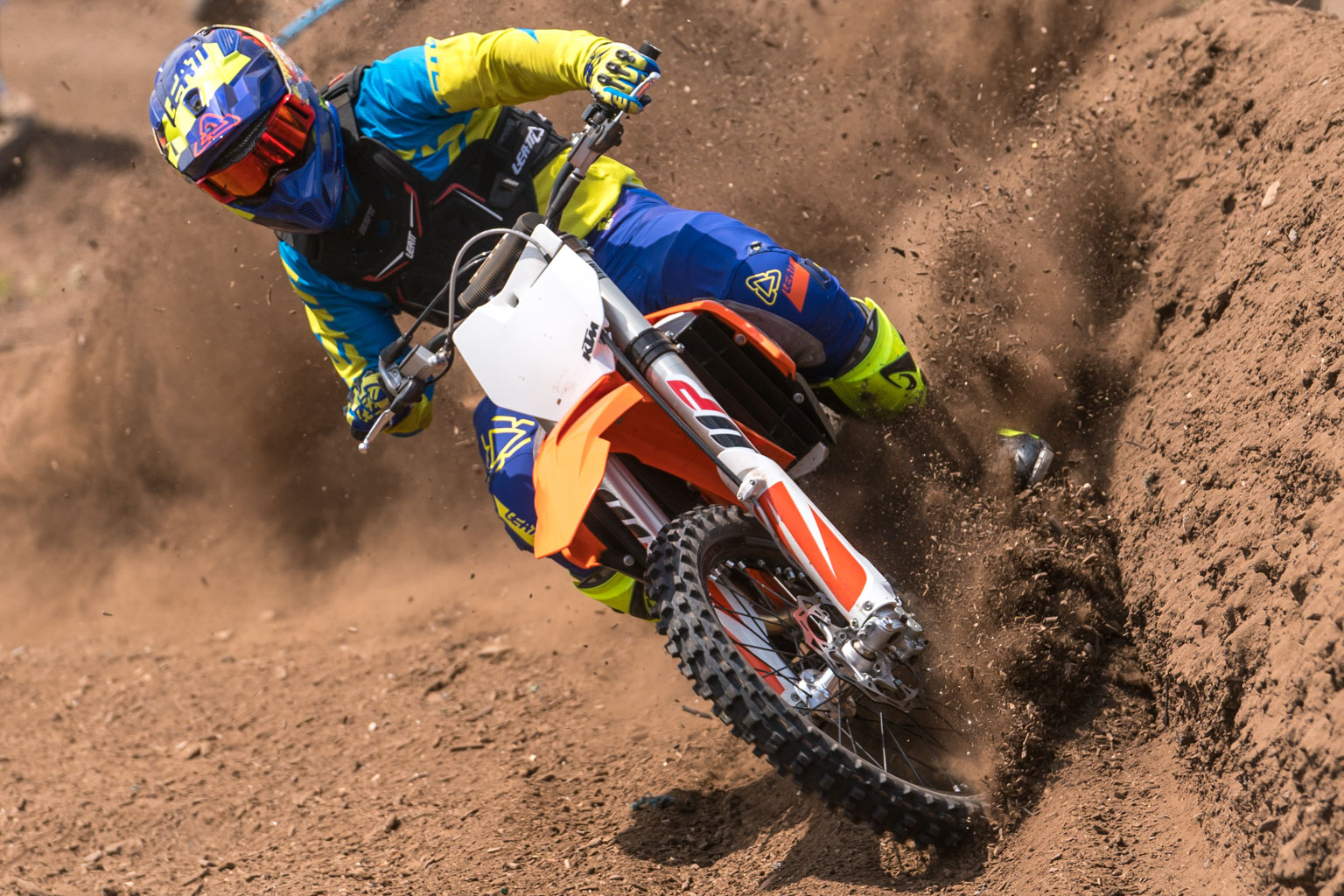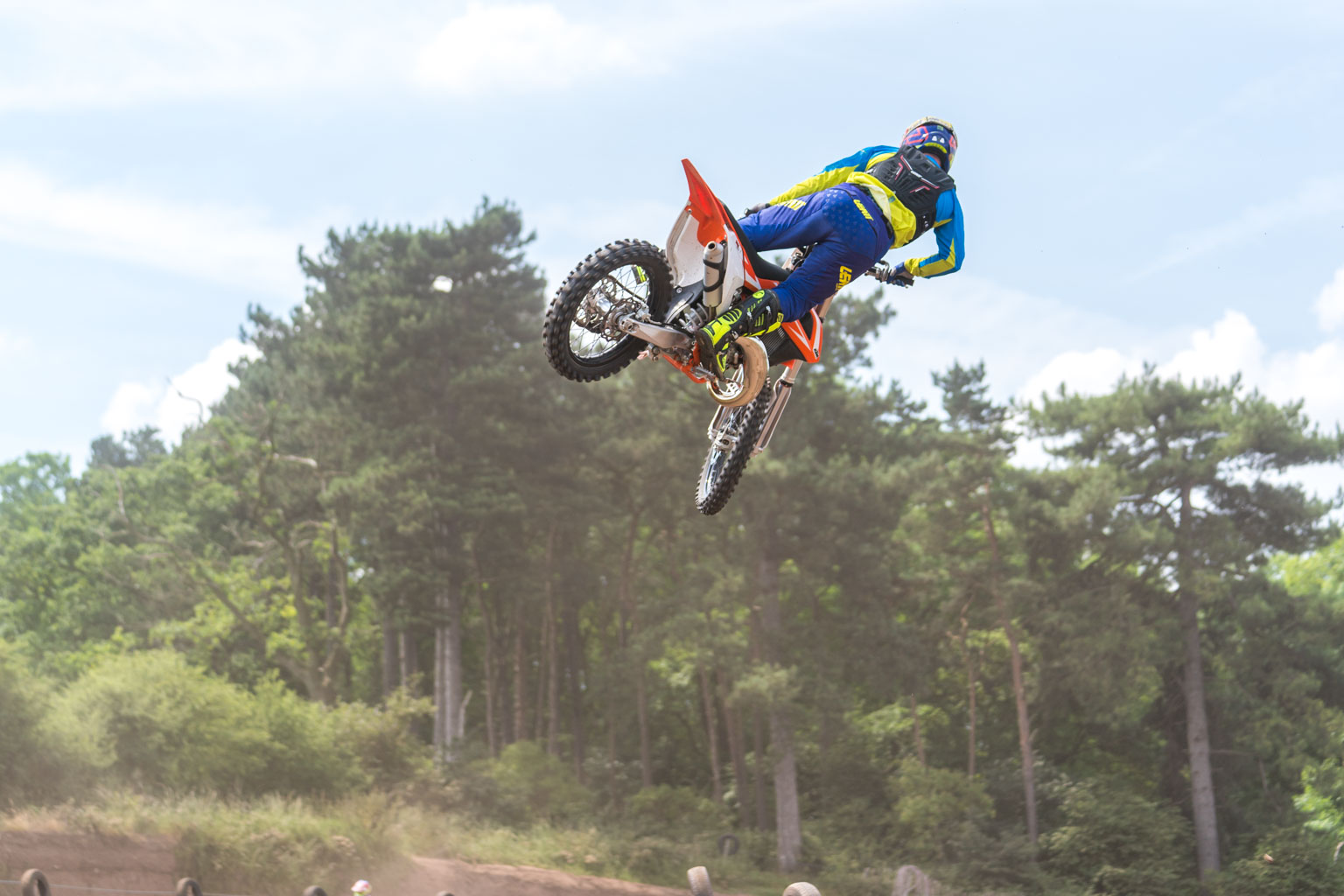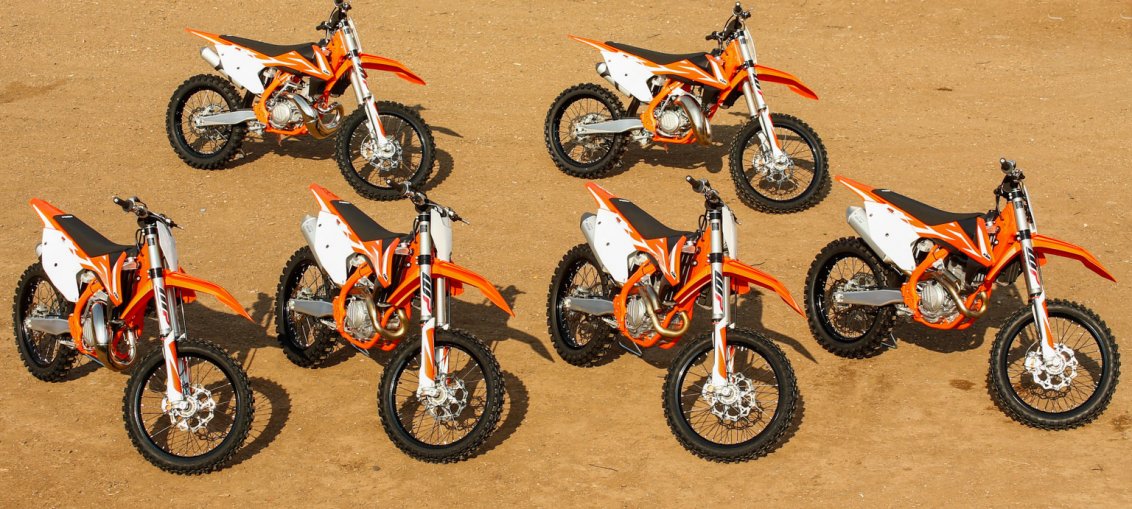
By Dave Willet. It’s fair to say there’s not a lemon in any of KTM’s orange bikes. The 450 and 250 are class-leaders, and the 350 has no real rival. As for the 125 and 250 two-strokes, they’re the newest kids on the block and feel more modern than anything else. That’s why race tracks around the world are full of orange bikes, or those very similar white ones made by sister firm Husqvarna. In the same factory with the same frame and engine.
KTM’s have proven to be fast, reliable and light. Since the new super-light range came out with all new bikes for 2016 – apart from the 250 smoker – the bikes have been a hit. The 250 two-stroke got its big changes for 2017 to bring it right up to date.
KTM hasn’t made many changes to its 2018 range. These little changes may suggest that something big could be coming in 2019, or they’re finding it very hard now to make any real improvements as the bikes are so good. With new bikes from Yamaha, Suzuki and Honda coming in 2018, KTM knows it can’t stand on its laurels any more so is probably working on big revisions right now for 2019.
For 2018, there are a few changes to talk about on the new range such as revised suspension, new radiator scoops and a change of frame colour to factory-style orange just like the GP and AMA bikes.
We’d already tested the Husqvarna range at Mildenhall a week before the KTM test took place at Apex. The bikes are so close in fact, if you took both engines apart next to each other you find they are identical. It’s only components that are different, as well as Husky’s one piece back end instead of KTM’s conventional aluminium subframe and airbox.
Husqvarna still say these two brands would grow to be more different in future. But 2018 isn’t the year that happens as the major components are still shared. In fact, for 2018 the Husqvarnas get the WP forks that were new on KTM in 2017. All other major parts are shared but the different airbox, plastics and other components mean the bikes do offer a different feel on track. The balance of the bike is one thing and so is the power response. The way that the power is delivered is slightly different. Let’s touch a little on that first before we go into the bikes themselves.
The four-stroke fleet received a cool bonus addition last year which is situated on the handlebar. KTM upped their game by giving you an easy push-button electronic system on the handlebar to change power settings. These different options should never be over-looked as they make a real difference. Another test rider at Apex who was a Pro who mentioned how good the mapping was on the stock bike and how he could feel huge differences by swopping to different map by just pushing a button. He explained he’d never tried the standard electrics before as he’d always put an aftermarket ignition system on from new.
That might be the right thing to do for some riders, but for the vast majority it’s necessary to understand the differences the mapping makes as it transforms the feel of the bike.
KTM’s mapping options is a massive step in the right direction as it’s so easy to use. You can push the button on the track while riding – it’s actually that easy. It’s also very easy to see the option you have selected as it lights up. I found the old optional flick switch of a few years back a pain as you couldn’t see the option clearly.
The options on the ECU mapping on the four-strokes is map one and two button with an optional TC button offering traction control. It basically works by monitoring the throttle and any sudden increases in RPM. It then adjusts itself to reduce power to the rear wheel, ensuring maximum traction. So a quick RPM spike and the ECU recognises it and adjusts the power until you get grip again I find the best map option is map 2 as it makes the motor rev through the range faster. It also lets the engine breathe a little more as it kind of feels strangled in map one over map two. But map one is easier to control for when the tracks are less grippy.
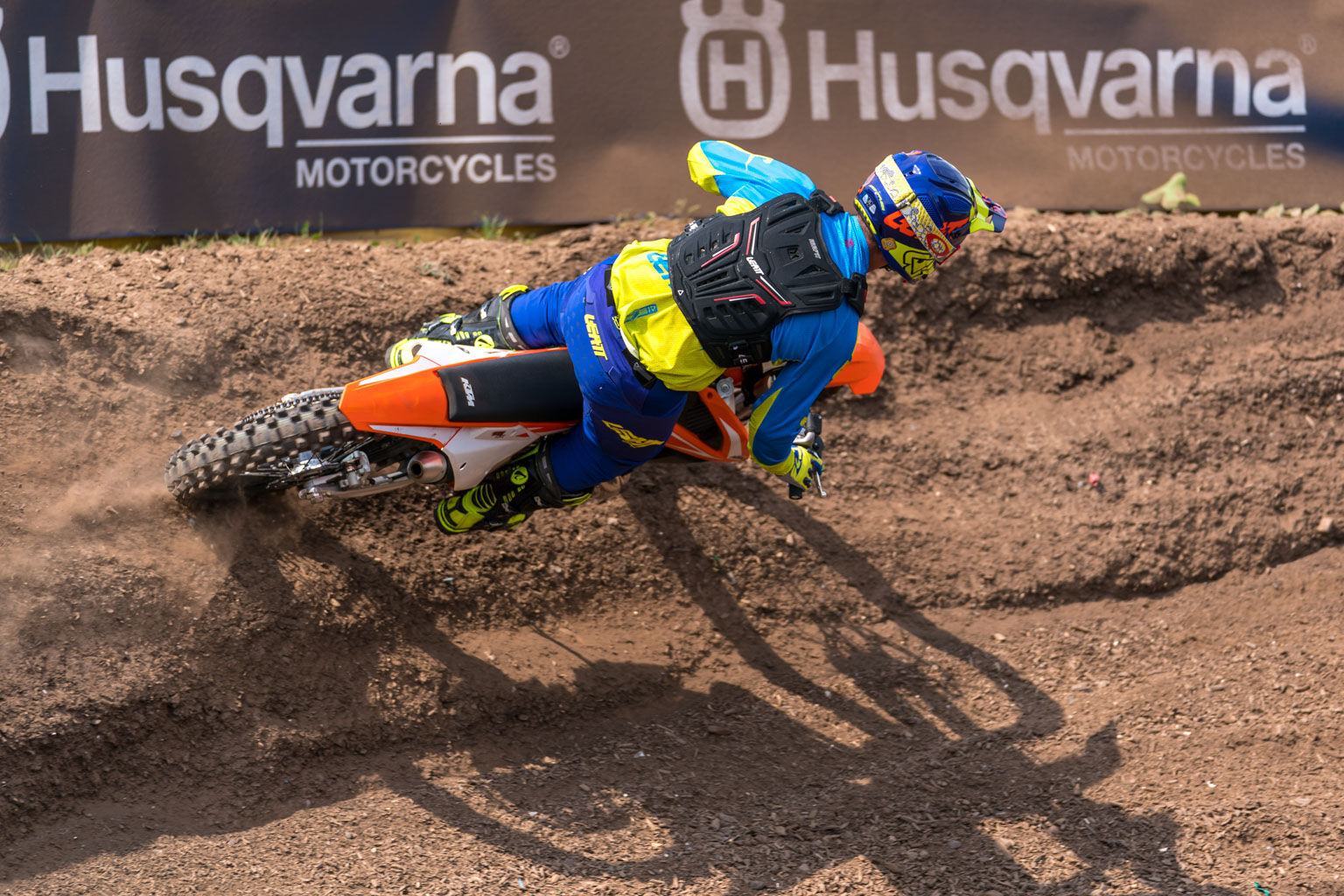
125/150SX
The 125 and its big-brother 150 had a new carburettor in 2017 which was a new Mikuni TMX 38mm flat side. Lots of riders havde said they have trouble getting adjusted to the Mikuni but I feel it’s fine once set up to the conditions you’re riding in. But one word of advise though before you start chasing your tail in the jetting department is to make sure the power valve spring is correct as I’ve ridden a few in the past with different tension set-ups from stock.
The 125 is always a winner out on track. It’s just fun to scream a bike and ride it hard. It’s one of my favourites of the range but I’m liking the 150 more and more these days as you can be less precise with gear changes.
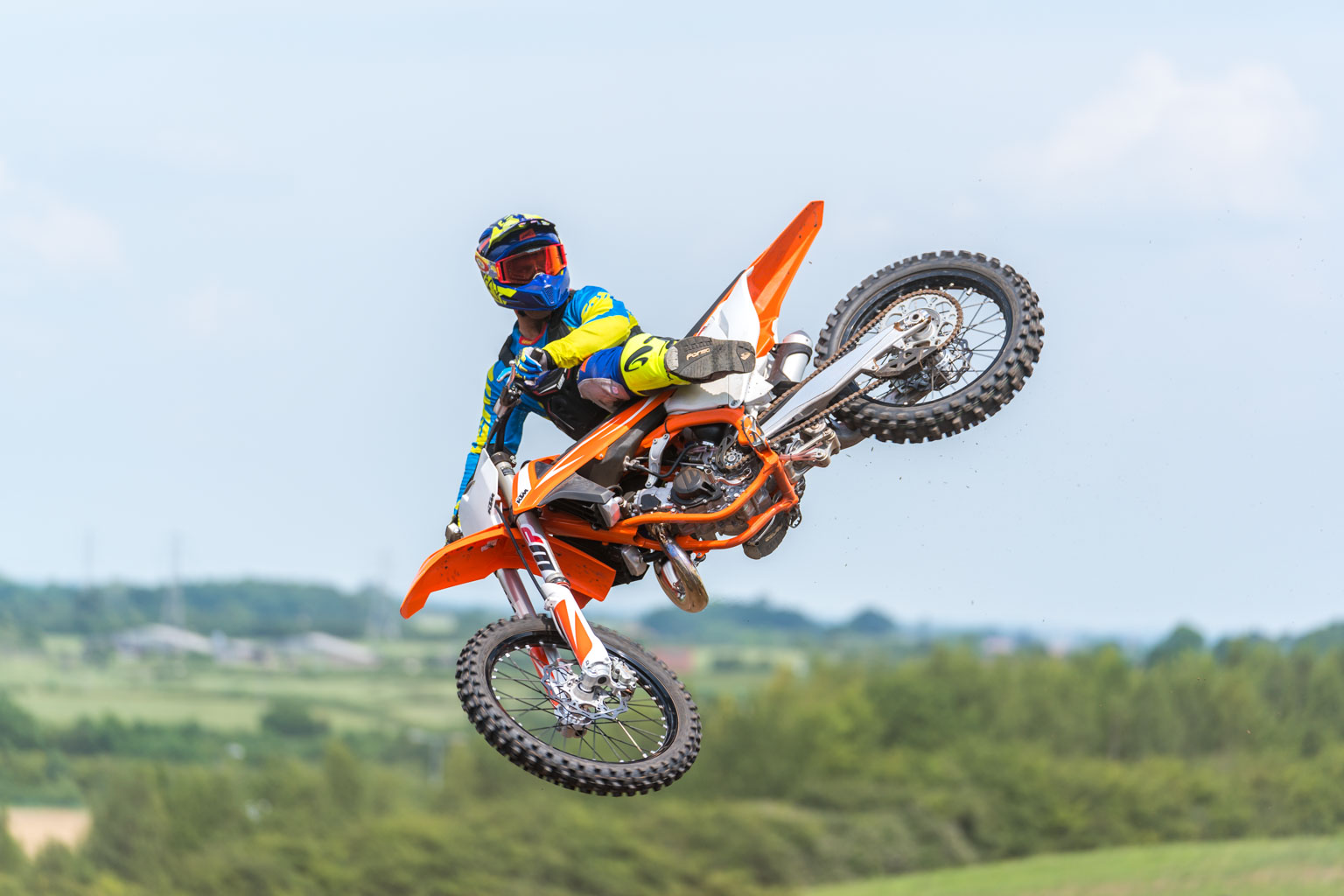
These machine are on point as the BHP output for a motor so small in capacity is incredible and it makes for good times around the track. The creative lines the super-light bike lets you use make it fun. The secret is to keep the motor pulling and for this to happen you have to be creative! The movability is what also makes this machine so great to ride and this is credit to development team as motor, chassis and suspension all work in sweet harmony. I rode the bike in full standard trim and felt right at home. Not even a sag adjustment was done, so I know with a few tweaks it could be tailored even better for me.
The power is long and really does stretch out – for a small two-stroke that is. I loved both bikes but I would clean up the bottom end jetting a tad. The KTM crew did just that before we started the day. They went for a quick fix by dropping the needle one clip to make it learner. The bikes come woolly in standard form and I know both the 125 and 150 aren’t cleaned up with an aftermarket pipe. So read the KTM manual and follow their revised carb settings as apparently they’ve done the homework for you. The KTM 125 and 250 two-strokes feels richer than the Husky range due to the airflow being different.
250SX
This bike has never been short in power and while nothing has changed in that department, the delivery in which the new engine puts the BHP to the ground makes for a much smoother ride. I find you can tackle the track with relevant ease now – more than you could in the past.
I actually liked this machine straight out the crate for the simple reason that you can rev it or use the torque of the motor which is pretty cool. I felt right at home straight away and found I could still play out on track.
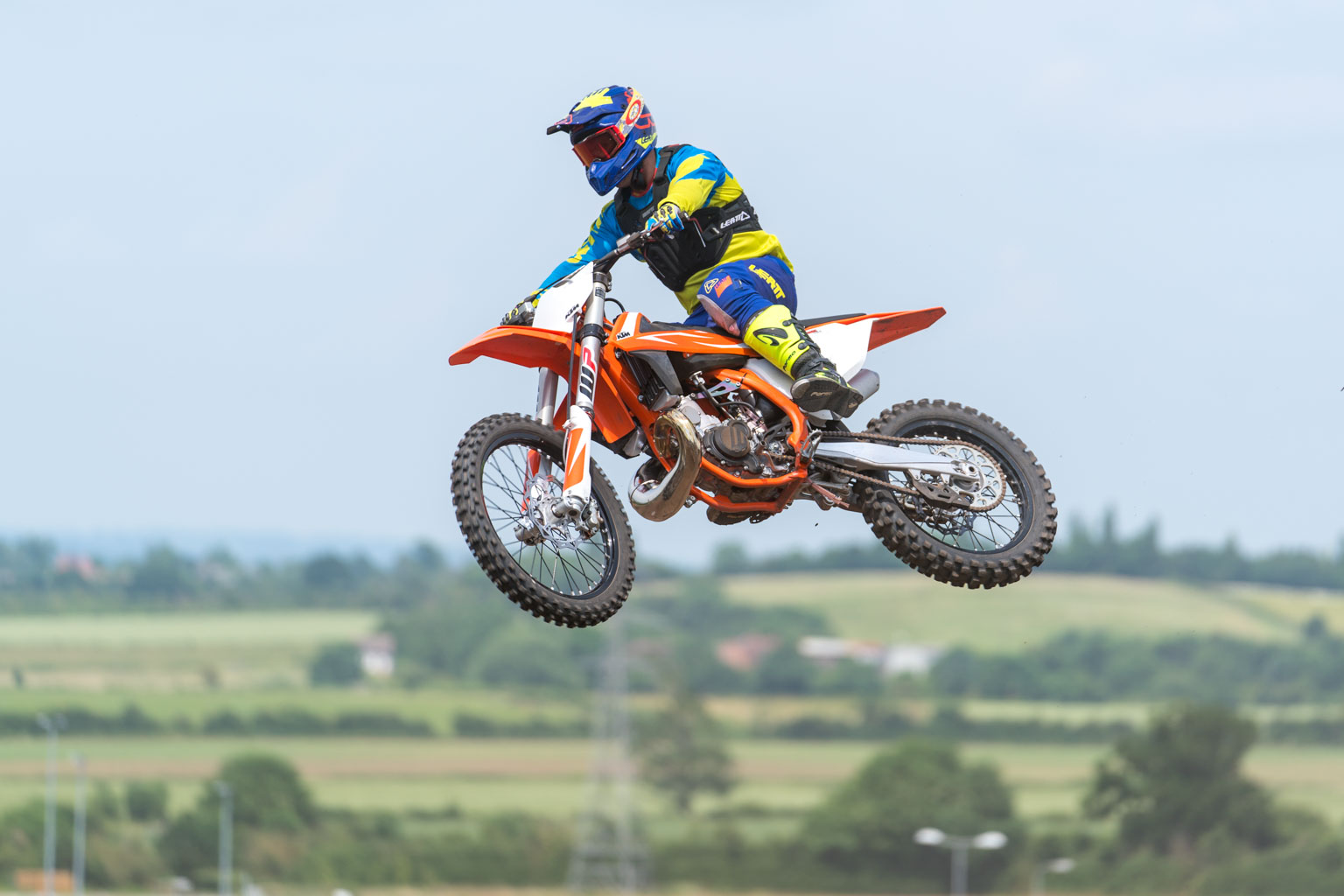
The full range of KTMs just feels well balanced and there’s nothing different here as the bike has the same frame and low-slung engine for a lower centre of gravity. It was all designed to work well together and it’s so moveable on the track.
The bikes comes a little rich in standard form, too. I’m sure we’ll see the number of 250 KTMs go up around the UK as everyone who rides it, loves it! Two-strokes are fun and a blast to ride fast. If that sounds like the bike for you, you won’t be disappointed with the KTM 250SX.
250F
Considering it’s the smallest four-stroke in the range, there’s nothing the 250F can’t tackle with relevant ease. I really like this machine out of the full four-stroke range for the simple reason that I respect the modest cc and what it can achieve.
In a way, it takes more finesse to ride a 250F than a bigger bike as you still have to ride it hard, and this is one bike that actually allows you to do so. You can hold a gear and rev it or use the torque of the motor which is pretty cool.
There are no surprises on the 250F. Everyone quickly feels right at home on it model and you can have lots of fun on the track with it, as its light feel and precise handling lets you go anywhere you want. It’s well-balanced and we all know the deal regarding power output – it’s right up there every year in the number game as it pushes out big BHP.

The 250F also has the mapping options of the rest of the four-bangers but to be honest the TC isn’t really needed on this bike – it’s more for 350 and 450. However the more potent option two map is highly recommend. It stretched out the power which is impressive every time you hit the track. Wheelieing long rollers in the same gear and not running out of revs is a huge advantage in the wood chip conditions of Apex. Everything on this model just seems to work really well – the power and chassis and even the suspension all complements each to create one awesome machine. If you want a fast 250 – and frankly, who doesn’t – then the KTM should be at the top of the shopping list.
350F
It may not have the kudos of being the bike Tony Cairoli spanks the 450s on any more, but the 350F has been everyone’s favourite for a number of years and rightly so. It’s close to being the perfect machine as it’s not sluggish off the throttle and is very free revving.
The power has been in it’s own league for the last few years as the BHP it produces can’t be compared to a fast 250F any more. It’s a stand-alone machine even though 250F and 350F share many of the same components.
Most riders at GP level run a 450 now, but for everyone else it’s still the best tool for the job in the UK as the circuits are so short. I always get asked about the 350 and I love answering questions about it. Many people ask why the majority of USA advice is to go 450 and my answer to that is if I was American I’d chose the 450 too, as their tracks are like motorways in the way of length and flatness.
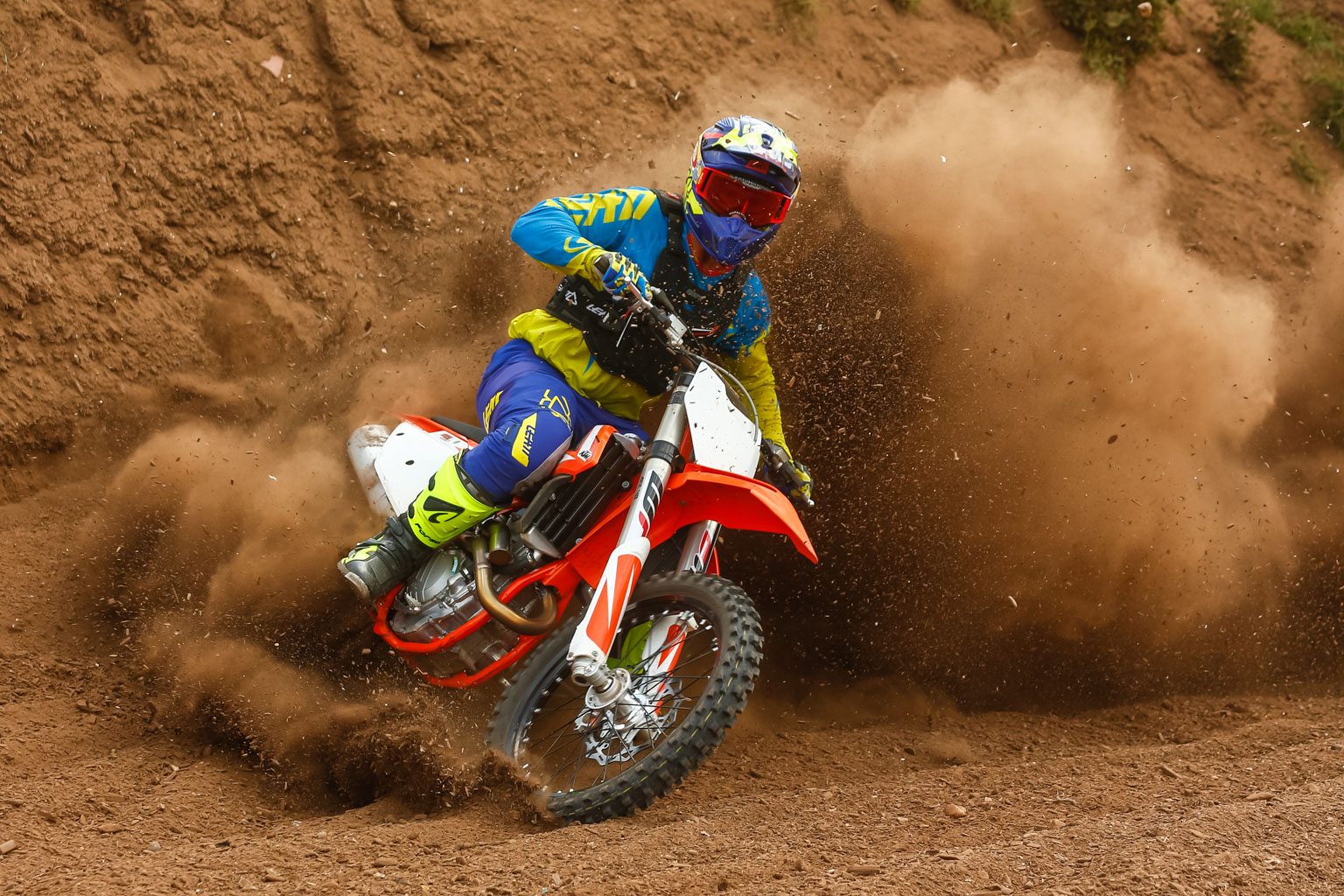
The 350 is still my bike of choice because feels so different in a good way. The extra torque over the 250 is very rider-friendly and gives the bike the edge in the market because it appeals on so many levels.
In the past the 350 has always been the bike which I’ve noticed to be very nervous, especially under braking as the forces from the fast-spinning crank when rolling off the throttle takes a toll on the suspension settings. This isn’t the case any more as the suspension is now well sorted.
It’s the complete package now they’ve come along way since the bike was unveiled seven years ago now. All the electrics are welcomed on the 350 and I found the TC to be of real benefit when the track is slippery. And the more aggressive map two option really lets the motor rip. It’s a great bike, and one that the majority of riders should buy if they are being honest about their skill level and tracks they race on.
450F
While the 250 and 350 share a lot of the same parts, the 450 is quite a lot different and it shows KTM are keen to deliver the best they can. With years of feedback from the 450 Supercross and outdoor pro teams in America and Europe, this machine is a product of quality shared data. It results in the bigger bike not feeling like a big bike. It’s a small, compact machine which feels more weighty than its smaller rivals but it’s also very moveable.
I love the way this bike just kind of holds you to the ground and has the power that would satisfy most pro riders. It’s not super aggressive and every year the wide range of power surprises me. The power delivery is transferred so well to the ground, too. I found the TC worked well on this model but in all honesty if you’re constantly spinning up this bike, then you’re either super fast or in the wrong gear as the bike in standard form just drives through most conditions.
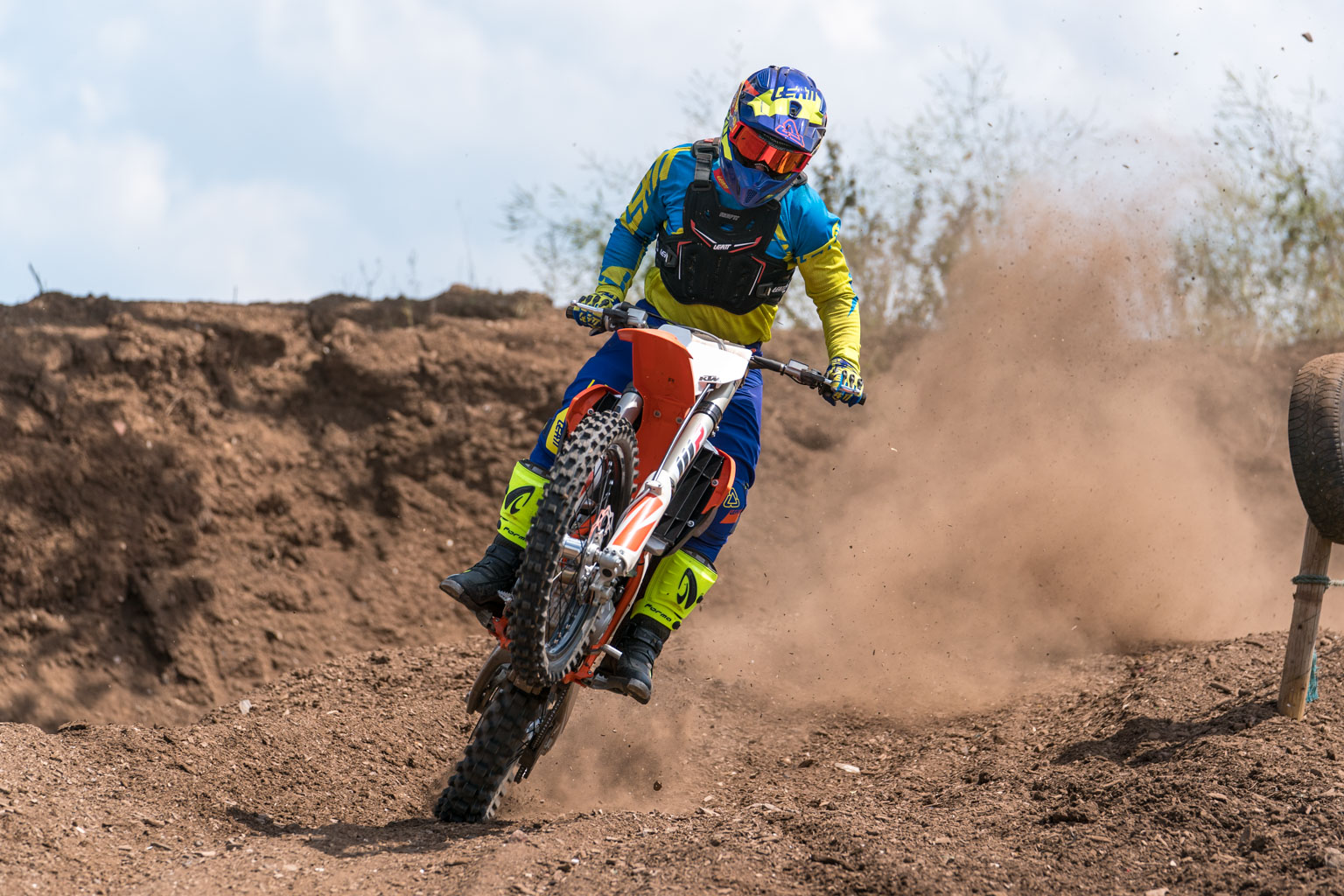
Map two is classed as the advanced map but I quite liked it on the 450 as the power felt smoother and more stretched out and the gear ratio is perfect. And if you want the bike to be mellow, then put the TC on.
Some riders found the bike too smooth but I’d say check out how fast the trackside posts are whizzing by. It’s such a smooth, easy to ride bike that you end up going faster than you thought if you’re not careful. The bike does feel marginally less aggressive than previous years. Not slower, just with a more refined power delivery. With its light weight, electric start, hydraulic clutch and simple WP air forks that are easy to set up, the 450 KTM is one incredible machine that’s designed to win races at all level.
